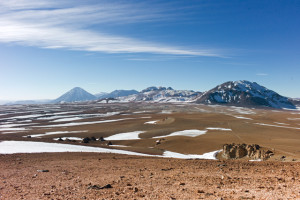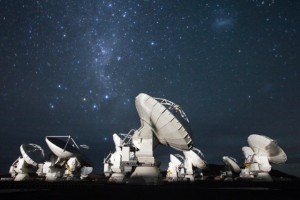Peter Lobner
The Atacama Large Millimeter / submillimeter Array (ALMA) is a single telescope composed of 66 high-precision, 12-meter antennas. ALMA operates at wavelengths of 0.3 to 9.6 millimeters. As shown in the following chart, this puts ALMAs observing range around the boundary between microwave and infrared.
 Source: physics.tutorvista.com
Source: physics.tutorvista.com
This enables ALMA’s users to examine “cold” regions of the universe, which are optically dark but radiate brightly in the millimeter / submillimeter portions of the electromagnetic spectrum. In that frequency range, ALMA is a complete astronomical imaging and spectroscopic instrument with a resolution better than the Hubble Space Telescope.
The ALMA Array Operations Site (AOS) is located on the Chajnantor plateau (which in the local Atacameño language, Kunza, means “place of departure”), at an elevation of about 5,000 meters (16,400 feet) above sea level in northern Chile.
On 30 September 2013 the last of the 66 antennas, each of which weighs more than 100 tons, was delivered to the AOS on the giant transporter named Otto (one of two available for the task) and handed over to the ALMA Observatory. The 12 meter antennas have reconfigurable baselines ranging from 15 meters to 18 km. Depending on what is being observed, the transporters can move ALMA antennas to establish the desired array. The transporters carry power generators to maintain the cryogenic systems needed to ensure that the antenna continues functioning during transport.
ALMA is managed by an international partnership of the European Southern Observatory (ESO), the U.S. National Science Foundation (NSF) and the National Institutes of Natural Sciences (NINS) of Japan, together with NRC (Canada), NSC and ASIAA (Taiwan), and KASI (Republic of Korea), in cooperation with the Republic of Chile.
The ALMA telescope is operated from the Operations Support Facilities (OSF), which is located at a considerable distance from the telescope at an elevation of about 2,900 meters (9,500 feet). The OSF also served as the Assembly, Integration, Verification, and Commissioning (AIVC) station for all the antennas and other high technology equipment before they were moved to the AOS.
The ALMA website is at the following link:
http://www.almaobservatory.org
You’ll find many downloadable ALMA-related documents on the Publications tab of this website. A good overview of the ALMA telescope and the design of the individual antennas is available at:
http://www.almaobservatory.org/images/pdfs/alma_brochure_explore_2007.pdf
ALMA press releases, with details of on many of interesting observations being made at the observatory are at the following link:
http://www.almaobservatory.org/en/press-room/press-releases
An example of the type of remarkable observations being made with ALMA is in the 16 July 2016 press release, “ALMA Observes First Protoplanetary Water Snow Line Thanks to Stellar Outburst.”
“This line marks where the temperature in the disk surrounding a young star drops sufficiently low for snow to form. A dramatic increase in the brightness of the young star V883 Orionis flash heated the inner portion of the disk, pushing the water snow line out to a far greater distance than is normal for a protostar, and making it possible to observe it for the first time.”
ALMA was looking in the right place at the right time. An artist’s impression of the water-snow line around V883 Orionis is shown in the ESO image below.
 Credit: A. Angelich (NRAO/AUI/NSF)/ALMA (ESO/NAOJ/NRAO)
Credit: A. Angelich (NRAO/AUI/NSF)/ALMA (ESO/NAOJ/NRAO)
You can read this ALMA press release and view a short video simulation of the event at the following link:
http://www.eso.org/public/usa/news/eso1626/
No doubt ALMA’s unique capabilities will continue to expand our knowledge of the universe in the millimeter / submillimeter portions of the electromagnetic spectrum. In collaboration with great land-based and space-based observatories operating in other portions of the spectrum, ALMA will help create a more comprehensive understanding of our universe. See my 6 March 2016 post, “Remarkable Multispectral View of Our Milky Way Galaxy,” to see how different a portion of the night sky can look in different portions of the electromagnetic spectrum.


